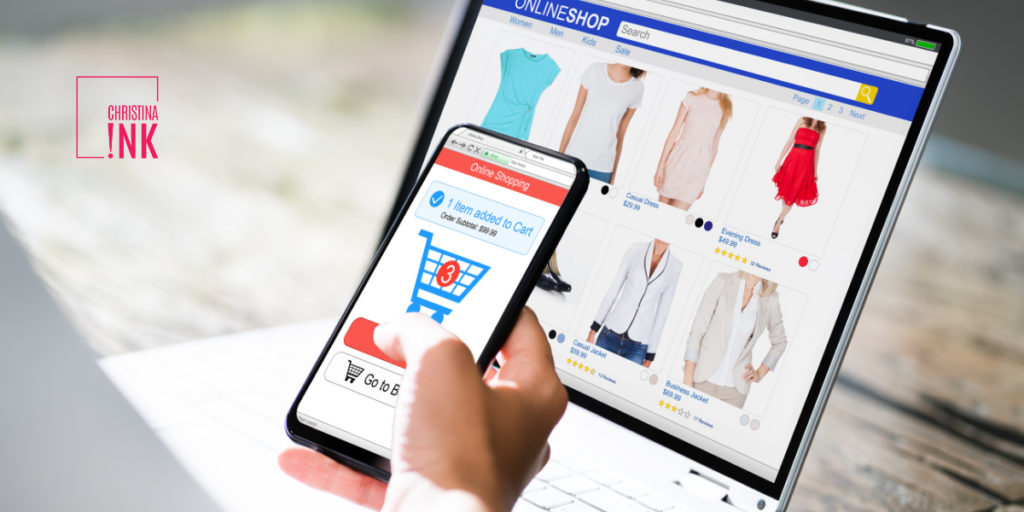For private label brands, creating engaging and persuasive website copy is crucial to establishing a unique brand identity, building trust, and ultimately boosting conversions. Read the full article to learn how to craft compelling e-commerce website copy.
Start By Unlocking Your Target Audience

Understanding your target audience is a critical aspect of writing effective website copywriting for e-commerce brands. By gaining insights into their demographics, preferences, pain points, and aspirations, you can tailor your messaging to resonate with them on a deeper level. In this section, we’ll explore some key strategies to help you truly know your target audience and create compelling copy that engages and converts.
#1 Conduct Market Research
The first step in unlocking your target audience is to conduct thorough market research. Start by identifying the demographics of your potential customers through research. Sites like Quora, Reddit, Answer The Public, and social media platforms hold valuable insights into your target demographic.
Consider factors like, gender, age, location, income, and occupation when performing market research. This data will help you develop a clearer picture of who your ideal customers are and how to communicate with them effectively.
#2 Create A Clear Buyer Persona
Buyer personas are key in writing e-commerce website copy that converts. Buyer personas encompass things like demographics, interests, goals, social media habits, content interests, and buying behaviors.
Creating detailed buyer personas can help you humanize your target audience and understand their motivations, allowing you to tailor your e-commerce copywriting specifically to their needs. Consider conducting surveys and interviews and analyzing customer data to gather for building an accurate buyer persona before you begin crafting your website copywriting.
#3 Identify Pain Points and Aspirations
To connect with your target audience, you need to understand your audience’s pain points and aspirations. What problems does your audience face that your private label product and brand solve? By identifying pain points and aspirations, you can position your Amazon FBA brand as the best solution and craft copy that speaks directly to the needs of your audience.
#4 Study Online Interactions
In the digital age, people leave a trail of valuable information through their online interactions. Take advantage of social media platforms, online forums, and review other e-commerce product websites to gain insights into your target audience’s preferences, interests, and behaviors.
Monitor discussions related to your industry, perform social listening and observe what influencers or thought leaders your audience follows. Take note of the types of content your audience engages with the most.
#5 Leverage Analytics and Customer Data
Analyze website traffic, bounce rates, time on page, and conversion rates to unlock your target audience. Consider collecting customer feedback through surveys, interviews, and Amazon reviews to gain firsthand insights into your customer’s experiences, pain points, and desires. This information can help you understand user behavior and preferences, allowing you to optimize your e-commerce content accordingly.
Knowing your target audience is vital for creating persuasive website copywriting for your e-commerce brand. By conducting thorough market research, creating accurate buyer personas, identifying pain points and aspirations, studying online interactions, and leveraging analytics and customer data, you can gain deep insights into your target audience’s preferences and behaviors. Armed with this knowledge, you can craft compelling copy that resonates with your audience, builds trust, and ultimately drives conversions. Remember, understanding your target audience is an ongoing process, so always strive to refine and adapt your strategies to stay in touch with their ever-changing needs.
How To Craft A Distinct E-Commerce Brand Voice

Developing a distinct e-commerce brand voice is crucial for creating website copy that connects and converts. Your brand voice encompasses the tone, personality, and style of communication you use to engage with your audience across your website and social channels. A strong brand voice helps you build a unique identity, and fosters trust and loyalty among your customers.
Learn the strategies Christina Ink leverages to develop distinct e-commerce brand voices for our clients:
#1 Understand Your Brand Identity
Define your brand values, mission, and vision. Consider the unique selling points of your e-commerce products or services, but also outline who you are as an e-commerce brand and what you stand for. Identify the emotions and feelings you want your brand to evoke in your audience.
#2 Choose the Right Tone
The tone of your brand voice should be reflective of your brand’s personality and the emotions you want to evoke. Do you want to be friendly and approachable? Professional and authoritative? Playful and humorous? Align the tone of your brand voice with your target audience.
#3 Be Authentic and Consistent
Authenticity is key to developing a distinct brand voice. Your voice should feel genuine and reflective of your brand’s values. Avoid imitating other brands or trying to be something you’re not. Consistency is equally important. Maintain a consistent voice across all platforms, creating a recognizable brand personality that resonates with your audience.
#4 Communicate with Clarity and Simplicity
An effective brand voice requires clarity and simplicity. Avoid overused jargon, technical language, and complex terminology that may confuse or alienate your audience. Instead, use clear and concise language that is easily understood. Keep sentences and paragraphs short and organized with bullet points and headings to break up content.
#5 Inject Personality and Storytelling
Infuse your brand voice with personality and storytelling elements to engage your audience on an emotional level. Share your brand’s unique story, values, and the people behind it. Use anecdotes, metaphors, or relatable examples to convey your message. By tapping into storytelling, you can create a meaningful connection with your audience that is remembered.
Continuously test, iterate, and refine your brand voice to ensure it remains relevant and resonates with your audience across all channels, including your website. By developing a strong and distinctive brand voice, you can differentiate your e-commerce brand and foster long-lasting relationships with your customers.
How To Formulate E-Commerce Website Copy that Connects and Converts

Crafting compelling website copy that connects with your audience and drives conversions is essential for the success of your online business. Whether you’re a seasoned e-commerce entrepreneur or just starting out, understanding the key strategies for formulating website e-commerce copywriting is paramount.
The goal of your e-commerce website copy is twofold: to establish an authentic connection with your audience and to inspire them to take action. It’s not enough to simply describe your products or services; you need to create an emotional bond that resonates with potential customers, ultimately leading them to make a purchase. Here are our top strategies below
#1 Craft A Clear and Compelling Brand USP
After you’ve outlined your target audience and your brand voice, the next step in crafting a conversion-worthy website is creating your unique selling proposition. Here at Christina Ink, we use a formula to help Amazon FBA brands unlock their USP.
Your USP should be visible on the home page of your website and should immediately and clearly tell shoppers who you are, what you offer, how you’re unique, and the transformation they can expect from choosing your brand. These two to three sentences are paramount to your website conversions. Do not skip this step.
#2 Craft Attention-Grabbing Hooks and Headlines
In the fast-paced digital world, captivating headlines are vital for grabbing visitors’ attention and enticing them to explore further. Craft compelling hooks and headlines that highlight the unique selling points of your private-label brands. Utilize power words, questions, and intriguing statements to pique curiosity and encourage click-throughs. Incorporate subheadings to break up the text and guide readers through your website, making it easier for them to find the information they seek. Keep headline sizes, fonts and colors consistent for a user-friendly experience that helps drive the sale.
#3 Focus on Benefits, Not Just Features
When writing website copy for your private label brand, it’s crucial to highlight the benefits your brand and products offer to your valued customers. While features are important, customers are primarily interested in how a product will improve their lives or solve a specific problem. Clearly articulate the value proposition of your brand and each product to emphasize how your private label brand can address pain points and fulfill desires. Use persuasive language and compelling storytelling to illustrate the transformative impact your brand can have on the lives of your customers.
#4 Analyze Competitor Websites
Analyzing your competitor’s e-commerce websites can provide valuable insights into crafting website copy that converts. Study how your competitors communicate with their audience through their unique selling proposition, the language and tone they use, and the key messages they highlight. Have they driven home their brand’s main benefits on the home page, and is their product offer clear and compelling?
By understanding the approach your private label competitors take on their website copy, you can refine your own website copywriting strategy to differentiate yourself from your competition. Offer a unique value proposition and a distinctive brand voice that sets you apart in the minds of your audience.
#5 Use Persuasive Calls-to-Action (CTAs)
Effective CTAs are critical in driving conversions. Clearly define the action you want your visitors to take, whether it’s making a purchase, subscribing to a newsletter, or following your brand on social media. Use action-oriented words like “shop now,” “sign up,” or “get started” to create a sense of urgency and motivate your audience to act
Consider incorporating scarcity or exclusivity elements to enhance the appeal of your CTAs.
#6 Incorporate Social Proof, FOMO, and Reviews
Private label brands often face the challenge of building trust with potential customers, especially as competition in the digital landscape widens. To overcome this, leverage the power of social proof by including customer testimonials, ratings, and reviews directly on your website. Displaying these elements in video format helps resonate with your audience and inspires them to buy instead of scroll.
Positive feedback helps demonstrate the quality, reliability, and satisfaction that others have experienced with your Amazon FBA brand and products. Fear of missing out can significantly boost sales while making them feel urgency in grabbing your transformational offer before it runs out.
#7 Refine and Update Your Website Copy
As market trends and customer preferences evolve, it’s crucial to refine and adapt your website copywriting to help build connection while meeting the demands of your customers. Stay up-to-date with industry news, and engage with your audience through social media and customer support channels. This will help you stay in touch with your customers changing needs, allowing you to adjust your website copywriting strategy to maintain relevance and effectively connect with your target audience over the long term.
#8 Enhance Your Website Copy with AI
In 2023, Amazon private label sellers have access to e-commerce copywriting tools and AI programs that can help you level up your content in the blink of an eye. Leverage clear prompts to achieve the desired outcome. Try copywriting AI tools to help you carve out your brand story, about us, and product descriptions. You’ll be surprised at the results.
Keep in mind that you’ll want to edit AI copywriting for accuracy, readability, and differentiation. Never solely lean on AI, or you risk sounding like every other e-commerce brand around.
Conclusion
Crafting persuasive e-commerce website copywriting for Amazon FBA brands requires a combination of strategic thinking, creativity, nd customer-centricity. By understanding your audience, developing a distinct brand voice, and focusing on benefits rather than just features, you can create engaging and compelling copy that drives sales and establishes your brand as a trusted authority.
Remember to incorporate attention-grabbing hooks and headlines, persuasive CTAs, FOMO, and social proof to enhance the impact of your copy. With these essential strategies and best practices in mind, you’re well on your way to writing the best e-commerce website copywriting for your private label brand.
Not sure where to start? We can help. We’ve crafted dozens of e-commerce websites, landing pages, and funnels for Amazon private label sellers, agencies, and coaches. Save 10% on your e-commerce website copy by mentioning this article. Contact us today to get started.

LIKE THIS ARTICLE?